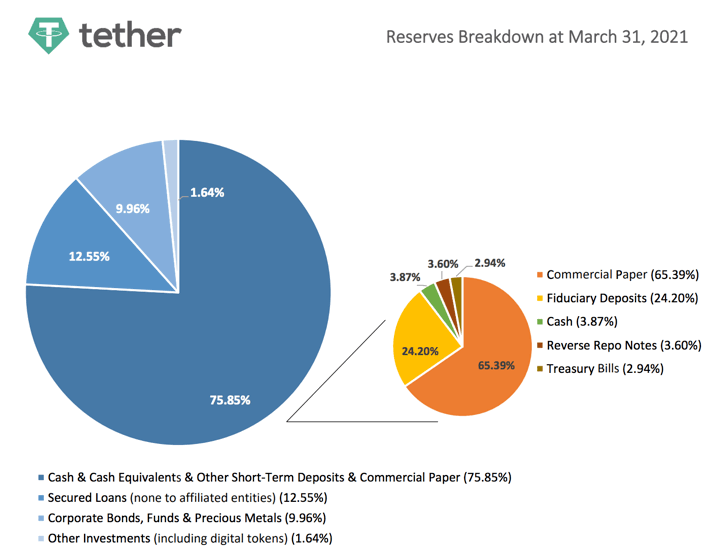
Tether is the largest US dollar stablecoin in the world, with a market cap of about $58 billion. Stablecoins are supposed to be backed by an equal amount of fiat money held in a trust account. 1 USDT should be backed by $1 USD. But how do you know? Tether just outlining the collateral backing its stablecoin as of 3/31/2021, and it’s…. a huge warning sign. Less than 7% is held in cash and Treasury bills, with the rest being a mix of vague commercial paper, loans to unknown entities, and honestly who-knows-what.

Alignment of interest. Keep in mind the concept of from David Swensen. Tether wants to seem as credible and legitimate and “NOT A SCAM” as possible. Everything they say will try to put them in the best light possible. In fact, Tether is only doing this because of a after being fined $18 million for lying in the past. (As recently as March 2019, Tether claimed it was backed by 100% USD cash.) Yet… this is the best they can do?
A single glance at this chart and I know that Tether is not taking my US dollar and whisking it away safely into a trust account at a regulated US bank. Instead, the people running Tether are using the collateral for their own personal gain. They are making loans, earning interest, all things that add risk while using other people’s money. Banks are allowed to do that within a highly-regulated environment. Tether is not a bank.
Liquidity risk. There is a reason why Warren Buffett only holds Treasury bills when he says “cash” and not commercial paper. When the poo hits the fan – and it will sooner or later – “cash” means you get your money out immediately and reliably. Tether will not be able to do this, given the composition of its reserves. This covers a lot of related concerns.
As the volume and velocity of stablecoins grow, the liquidity risk, of course, will grow too. For this reason, it will become increasingly important for the banks managing stablecoin cash to be nonlending banks or perhaps liquid asset banks that ring-fence the investments in segregated, bankruptcy-remote accounts — and, again, invest the assets backing stablecoin deposit liabilities in 100 percent risk-free, short-term, and liquid assets. Indeed, one reason why Wyoming chose its Special Purpose Depository Institution (SPDI) charter to be a nonlending charter is precisely because leverage and digital assets do not mix. Let me pause and repeat that — leverage and digital assets do not mix. Digital assets generally settle in minutes and with settlement finality, which means leveraged financial institutions that handle them could quickly find themselves in trouble if they don’t manage the liquidity risk well — digital assets move fast. So, there’s a fundamental reason why digital assets should interface with the traditional financial system via nonleveraged banks whose demand deposit liabilities are 100 percent backed by risk-free, short-term, liquid assets.
Instead of 100% risk-free, short-term, liquid assets, Tether is less than 7% risk-free, short-term, liquid assets. Commercial paper? Backed by whom exactly? Fiduciary account? At which remote offshore bank owned by a third-party? They could be pointing to a half-eaten sandwich and calling it collateral.
As a result, I would never own Tether, and if such behavior continues to be allowable, it would make me more skeptical of the other stablecoins like USD Coin (USDC) and Gemini Dollar (GUSD), even though they do claim to be fully-backed by dollar reserves in a US Bank. (Gemini and Circle are also regulated by the New York State Department of Financial Services, while Tether is not.) Regulation around stablecoins is so limited that we’ll probably have to experience some sort of major loss event before this gets addressed, just as we had to suffer deposit losses from failed banks before FDIC-insurance came around.
Having a clear stance on cryptocurrencies is tricky. On one hand, it is definitely a “Wild West” situation and there is certainly fraud and shady practices involved. On the other hand, this is how disruption works, and I don’t like anyone confidently telling me the future when nobody knows the future. I would rather try to learn about it, look for opportunities, but also remain very skeptical and careful. If you are holding a lot of Tether, possibly due to the , please consider yourself warned.
Also see:
“The editorial content here is not provided by any of the companies mentioned, and has not been reviewed, approved or otherwise endorsed by any of these entities. Opinions expressed here are the author’s alone. This email may contain links through which we are compensated when you click on or are approved for offers.”
from .
Copyright © 2004-2021 MyMoneyBlog.com. All Rights Reserved. Do not re-syndicate without permission.